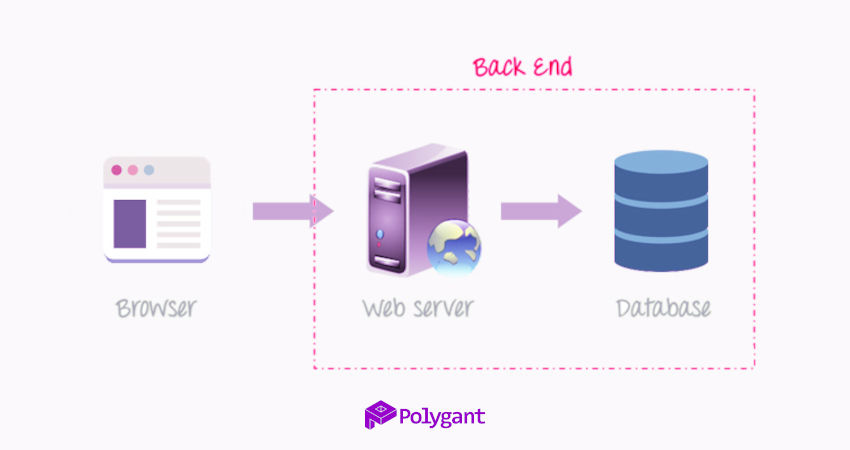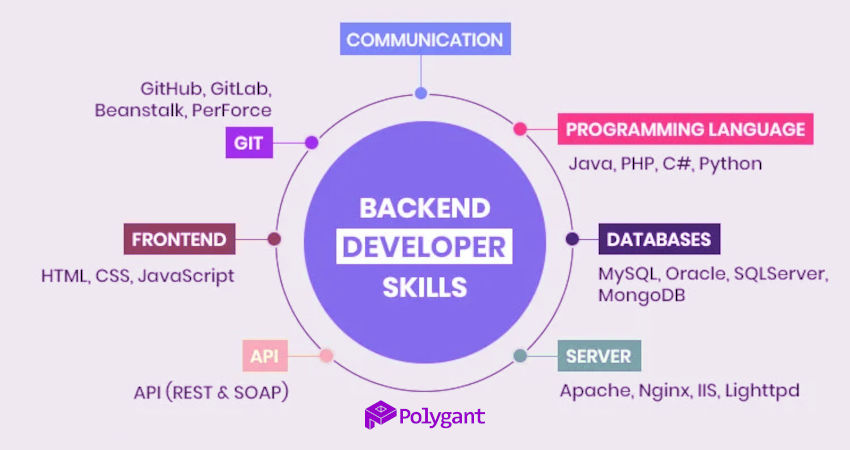Modern technologies are rapidly developing. To create a cool or at least a competitive web application today, you need not just one programmer, but an entire team of professional developers. This typically consists of UI and UX designers, a layout maker, as well as front-end and back-end developers. In this article, we’ll talk a bit about the latter — individuals whose work seems invisible, but is actually paramount in development.
Table of Contents
What a back-end is
The back-end is the software and hardware part of a web application. These nuts and bolts are on the server and unseen by visitors. What they see on the client side—in browsers on their devices—that’s the front-end.
The back-end is always tightly interconnected with the front-end. If we compare a web application with a car, then the back-end is its internal mechanisms, from the radiator to the rear axle, and the front-end is the body and interior.
What languages the back-end is written in
For every project, a suitable programming language is chosen in which the source code will be written. These 5 programming languages are most often used when developing web applications:
- Java.
- Perl.
- PHP.
- Python.
- Ruby.
A back-end developer is not required to be proficient in every programming language. Yet, a talented specialist is capable of quickly learning a new language, and then easily solving tasks where it is needed.
Databases are almost always used in the back-end, and they are written using SQL (Structured Query Language). Being proficient in it helps to work with any relational DBMS, for example:
- MariaDB
- Microsoft SQL Server
- MySQL
- Oracle RDBMS
- PostgreSQL.
What back-end developers do
Back-end developers work on business logic, design future web app architecture, create core functions, as well as implement APIs and libraries. They may also be responsible for the server software, administration, and systems security, but this is usually the responsibility of DevOps.
Back-end developers’ direct responsibilities additionally include working with databases. The use of a DBMS allows not only for the storage, but swift processing of large amounts of data about web app users, goods and shopping carts, reviews and comments.
Back-end developers are also engaged in optimising and integrating systems, as well as the subsequent maintenance of the web application and release of new versions. They can also test different versions or specific features, but it is better to have separate testers with a fresh perspective.
What skills back-end developers possess
A typical back-end specialist is fluent in English. A lot of programming literature, reference books, and instructions become accessible due to this knowledge because almost all of them are written in English. And if the developer is involved in foreign or international projects, then without confident English, they are unlikely to fit into the workflow.
A professional back-end developer can also be distinguished by such personal qualities as an analytical mindset and structural thinking. An additional plus will be a well-developed imagination, attention to detail, and the ability to work in a team.
What back-end developer is right for you
Choosing a talented back-end developer isn’t simple. If you need them for remote work, then you can search amongst freelancers, or resort to outsourcing a ready-made team of developers, which necessarily includes back-end devs. If you need a full-time back-end dev for the office, then you can use your HR department or a recruitment agency. Which option is better is certainly hard to say, so you need to consider the pros and cons of all the choices out there.
Freelancers
By choosing to hire a freelancer, you entrust the work to a person who’ll only be responsible for specific tasks, but not the project as a whole. Keep in mind that a freelancer often works with different employers simultaneously, and therefore is working on several projects at once. When this is the case, it’s unknown whether your project will have the same priority for them.
Despite this shortcoming, employers regularly hire freelance back-end devs. This option is still attractive for its savings on development, when compared to members of a professional team or full-time employees.
Remote outsourced team
By choosing to outsource back-end development to a well-coordinated team, you’ll get full reports and accompanying documents with seals. In this case, they’ll help you develop a high-quality, guaranteed web application. And the group will be headed by a team lead, which will save you from having to compile, assign, and check tasks.
Yet, this method of collaborating assumes that the hourly rate of a team back-end dev will cost about twice as much as a lone freelancer. The average market rate is 45 EUR or 50 USD.
Staff developers
By choosing to hire an employee, you’ll also get a high-quality back-end, but only you or your managers will control the work. A full-time employee will always be there, so you can load them with any sorts of tasks during working hours.
This hiring method is the most expensive because you’ll have to regularly pay salaries, taxes, insurance, and social benefits. And if the employee hired doesn’t work out, then it won’t be possible to part ways with them immediately — the labour code doesn’t permit that.
Having trouble deciding who is right for your web project? Then try all the options, one by one. Start by looking for a back-end dev on freelance or IT service marketplaces. Then drop us a line, we’ll provide you with a development team or assign specialists for specific tasks.


 Telegram
Telegram 

